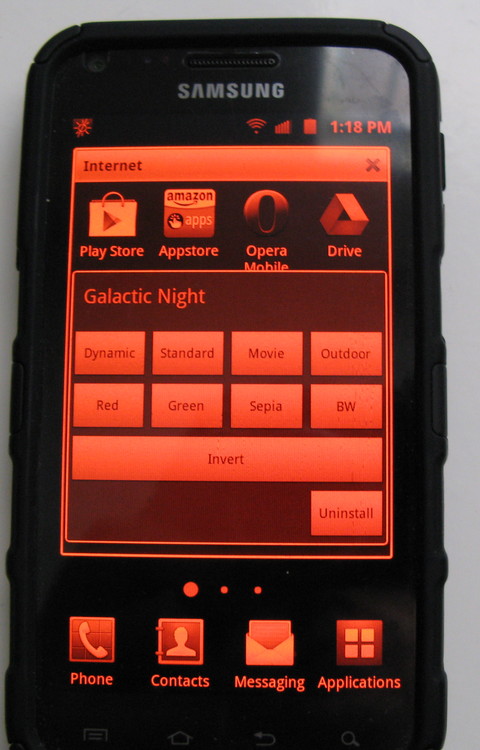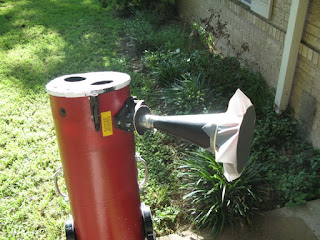Tuesday, August 14, 2012
Galactic Night released
Sunday, August 5, 2012
Progress on Samsung night mode
Saturday, July 28, 2012
Samsung red mode
I am working on a better red night mode for rooted Samsung phones. The usual way to do red mode for rooted Android devices is to use ChainFire3D. However, ChainFire3D does red mode simply by dropping the green and blue components, and as psonice once pointed out to me, that's not the best way. After all, then, green and blue stuff on the screen is invisible.
The right way to do it is to combine the color components, using an RGB to grayscale conversion, and then use the red component.
I just managed to do it on my rooted Android 2.3 Epic 4G Touch using Samsung's MDNIE profiles (see screenshot) and some simple shell scripts. But I don't know if this will work on other Samsung phones, though I assume all Galaxy S2 family phones will work with my method.
A good rule of thumb is that a version of this hack should work on all rooted Samsung phones that have the Dynamic/Standard/Movie color mode switcher under Settings | Display | Screen mode.
If you want to help me with this project and have a rooted Samsung phone, there are some things you can do:
- (Easy, and you can do it even if your phone isn't rooted.) Go to Settings | Display | Screen mode and see if you have Dynamic/Standard/Movie switch. Tell me (either by email or by commenting) which phone and OS version you have, whether it has the switch, and whether it has these three or some other modes there.
- (A little more advanced and needs root.) Email me your /system/etc/mdnie_tune_movie_mode and /system/etc/mdnie_tune_ui_standard_mode files , also telling me which phone and OS version you have.
You can email me at arpruss at gmail dot com, with subject line "red".
The resulting switcher will be free and open source.
Tuesday, July 10, 2012
LunarMap HD USGS Geologic Map
Notice in the screenshot how the labels hard-printed on the map get combined with the yellow labels added by LunarMap, without any duplication of labels.
Tuesday, June 5, 2012
Transit of Venus
This is from my 8" F/4.5 scope, stopped down to about 3", with photo taken hand-held with my Canon G7 camera off the projection funnel.
Here is the last photo in a larger size. The sunspots were very nicely visible in the funnel (I counted about 15), and I could even see two without a telescope in the #14 welder's glass. The photo doesn't do justice to the sunspots, especially the nice bright area that was just barely visible at the bottom of the disc.
Sunday, May 20, 2012
Eclipse
And for reference, here's the sun in the afternoon, before the eclipse:
Sunday, May 13, 2012
More sunspots
Saturday, April 21, 2012
Friday, April 20, 2012
More sunspots
I noticed that they were very much in pairs. Apparently sunspots come in pairs with opposite magnetic polarity.
Tuesday, April 17, 2012
Sunspots today
I played with it today to see how far away from the eyepiece I'd need to get to have a 4" image in my 8" F/4.5 (stopped down to two 3" apertures). Answer: ~26cm. When I projected the sun on a piece of cardstock, at that size, I was blown away by the richness of the structure of the sunspots today. And the sun was quite low, as it was shortly before sunset. Here's today's LMSAL photo. I saw the two larger groups but somehow missed the smaller group that's down from center.
It's time to build a sun funnel as soon as my projection material comes.
Thursday, April 5, 2012
Hard drive platter as flat mirror
I was just playing with looking at stars reflected in this platter through my 15x70 binoculars, with only one eye. There was some unidirectional glare from Venus, but stars looked pinpoint. I was only hand-holding the binoculars, so the test isn't great. And it would have been better if the central hole was blacked out. This isn't a very demanding test, higher magnification would be much better, but it's a promising start.
Sunday, April 1, 2012
Mars
I had a 75mm single-hole aperture mask that I was planning to use in my 8" F/4.5 Coulter for solar projection, but tonight I added another hole to it. Both holes miss the two-vane spider. The views of Mars with the aperture mask and a 5mm ortho are great--best I've had. Two dark areas (one was probably Mare Acidalium) and a bit of polar cap. I don't know if they're better with two holes than with one--there may be better contrast with one--but they are a bit brighter with two, and I love the easy focusing (with the mask, you see double and you focus by merging the images).
Saturday, March 31, 2012
More solar observing experiments
While ordering from Surplus Shed, I also ordered a 15mm focal-length Hastings triplet. If it does not make a good planetary eyepiece--I will certainly will try--I will have a nice 15X loupe, replacing my 15X plastic-lens loupe (which is usable, but only in the center of field).
Monday, March 26, 2012
Solar observing mishap
But then the images went foggy. And I couldn't get them in focus. And smoke started coming out.
I disconnected the Kellner and noticed the lens was fogged up. Turns out that while the eyepiece housing was metal, as it should be for solar work, the eyepiece lenses had a plastic spacer. Which melted. The spacer is the black thing to the left of the lenses.
The lenses cleaned off fine with acetone. But I wonder how I can find a metal replacement spacer.
So, that's a warning for solar work: don't assume that just because the eyepiece tube is metal, the inside is metal, too.
Saturday, March 10, 2012
LunarMap 1.11 for Android
- Add satellite features (e.g., Plato B) [HD only]
- Adds astronaut-named features
- Improve memory handling
- Fix bug with selection of feature types
- Add a little more info about feature types
I will upload to the Amazon Appstore on Monday if all is well.
Saturday, February 25, 2012
Solar projection scope prototype
I got the following lenses from Surplus Shed:
- 150mm diameter PMN, 2600mm focal length (stock L3855D, $25)
- 68.7mm diameter NMN, -800mm focal length (stock L4380, $4)
Tuesday, February 21, 2012
Shadows and light
I hadn't done much astronomy lately. I did notice lately that Venus was getting very far in the sky from the sun, and it was gratifying to see this coordinated with the slightly more than half-illuminated face of it. I suppose it will now be getting closer to it, culminating in the transit this summer.
Monday, January 23, 2012
Solar projection telescope
I still don't know how I'll direct sunlight into the scope. My first attempts will use a hard drive platter as a super-cheap mirror.
Sunday, January 22, 2012
Open Star Map for Android
There are a lot of unsatisfactory things about Open Star Map. For instance, the night mode doesn't change everything. For another, the catalogs are shallow.
Saturday, January 21, 2012
Google Sky Map now open source
Just built it with Eclipse. To build, download the source via svn. Then:
1. Import trunk/app as an existing-source Android 2.3.3 project.
2. In the Project Properties, go to Java Build Path and Libraries.
2.1. Press "Add JARs..." and select libGoogleAnalytics.jar from trunk/app/libs/libGoogleAnalytics.jar
2.2. Press "Add External JARs..." and select the two jars from trunk/tools/libs























